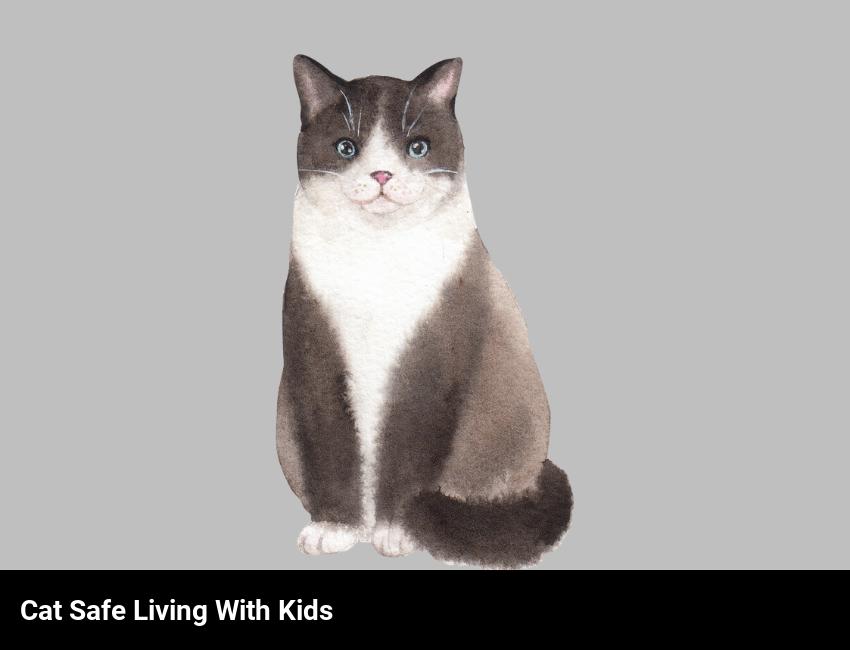Cats And Children: How To Keep Them Safe
To keep cats and children safe, always supervise them when they are together. Teach children to be gentle and respectful of cats, and make sure cats have a safe and comfortable place if they need to retreat.
As a parent of both a young child and a cat, I can tell you firsthand that living in a household with cats and children can be both rewarding and challenging. After all, cats and children are two very different creatures with their own unique needs.
From my own experience, I’ve learned that it is important for parents to understand the risks involved in having cats and children in the same home and how to keep them both safe. I’ve also learned that teaching children to properly interact with cats is essential.
With the right guidance and a few simple tips, parents can ensure that cats and children can coexist peacefully in the same household.
In this blog, I’ll be sharing my personal experiences and what I’ve learned throughout the years of living with cats and children.
I’ll be discussing the risks associated with having cats and children in the same household, tips to help keep children safe around cats, signs that cats are feeling uncomfortable around children, and how to teach children to properly interact with cats.
Most importantly, I’ll be sharing why it’s so important for parents to supervise cats and children when they are interacting.
What are some of the risks associated with cats and children in the same household?
Cats and children can coexist in the same household, but there are risks associated with them being together. The most important risk is that cats can scratch and bite, which could be dangerous for children. If a child is not familiar with cats, they may be scared or intimidated, which could lead to an unfortunate incident. Additionally, it is important to keep in mind that cats may be more active at night, which could disturb a child’s sleep.
Another risk is that cats may carry parasites, such as fleas and ticks, which could be harmful to children. It is important to monitor the health of your cat and make sure they are regularly treated for any parasites. Additionally, cats may carry diseases that can be passed to humans, such as rabies and ringworm, so it is important to take all necessary precautions when it comes to handling cats.
Finally, cats may be territorial, and if they feel threatened by a child, they may lash out. It is important to keep a close eye on cats and children when they are together and make sure the cat is not feeling overwhelmed or threatened. Additionally, it is important to teach children the proper way to interact with cats to help ensure their safety.
Overall, cats and children can coexist in the same household, but there are risks associated with them being together. It is important to be aware of these risks and take all necessary precautions to keep everyone safe.
What are some tips to help keep children safe around cats?
If you have cats and children in the same home, here are some tips to help keep everyone safe:
- Make sure your cat is up to date with their vaccinations and flea/tick treatments. This will help protect both your kids and your cat from any illnesses.
- Teach your children never to pick up or disturb cats when they are sleeping or eating.
- Explain to your children the importance of being gentle and quiet when interacting with cats.
- Teach your children to always wash their hands after touching, petting, or playing with cats.
- Make sure your cat’s litter box is in a place where children cannot access it.
- Supervise any interaction between cats and small children.
- Make sure your cats have plenty of places to “escape” to in case they need some alone time.
- Provide your cats with toys and scratching posts to keep them entertained and occupied.
- Always provide your cats with fresh food and water.
- Make sure your cats have access to their litter box at all times and keep it clean.
What are the signs that cats are feeling uncomfortable around children?
If you suspect your cat is uncomfortable around children, there are a few telltale signs you can look out for. Firstly, your cat may start to act out more aggressively, hissing and growling, swatting or even biting. Secondly, your cat might seem more timid and withdrawn, avoiding contact with children and hiding in quiet, out-of-the-way places. Thirdly, your cat might start to exhibit signs of stress, such as excessive grooming, uncharacteristic vocalizations, and changes in sleep patterns.
Remember, cats are sensitive creatures and it’s important to make sure they feel safe and secure when around children. If you notice any of the above signs, be sure to take steps to ensure your cat’s comfort. Give your cat a safe, quiet space away from the children and provide plenty of enrichment and toys to keep her busy. Make sure to provide regular opportunities for your cat to have one-on-one time with adults, too.
Finally, it’s important to teach children to respect your cat’s boundaries. Explain to them that cats have different needs and preferences than people, and that they should never chase or corner your cat. Encourage them to approach your cat slowly and calmly, and never force your cat to interact with them. With a little patience, understanding, and love, cats and children can learn to coexist peacefully.
Why is it important to supervise cats and children when they are interacting?
It’s essential to supervise cats and children when they are interacting. Cats and children both have the potential to be unpredictable and if they are left unsupervised, it can put both of them at risk. Supervision ensures that they are both safe, and it allows you to intervene if either of them gets overwhelmed or scared.
By supervising cats and children together you can also help them both to develop a positive relationship. You can monitor the interaction and intervene if either of them appears to be getting scared or irritated. You can also keep an eye out for signs of aggression and intervene if necessary. Additionally, you can praise them when they interact appropriately, which can help to reinforce positive behaviors.
Finally, supervising cats and children together can help to build trust and understanding between them. If you are present to intervene if needed, it will help them both to feel more secure. With your guidance, cats and children can learn to interact safely, and they can even learn to appreciate each other’s company.
In short, to keep cats and children safe, it’s important to supervise them when they are interacting. With supervision, you can intervene if needed, you can help them to build a positive relationship and you can help them to learn to trust each other. Supervision is key to helping cats and children develop a safe, respectful relationship.
How can parents teach their children to properly interact with cats?
As a parent, teaching your children to interact with cats properly is key for their safety and for the cat’s wellbeing. It all starts with teaching your kids about respect. If a cat is sleeping, eating, or being held by someone, your children should be taught to respect its space. Explain to them that cats may become scared and could defend themselves if they feel threatened.
Encouraging your kids to interact with cats in a gentle manner is also important. They should not be aggressive with cats, as this could cause them to become defensive. Instead, they should be taught to be gentle and use slow, soft movements when petting cats. If the cat does not want to be pet, don’t force it. Let them know it is okay to simply observe and admire the cat from afar.
It is also helpful to teach your children how to properly pick up a cat. If a cat is okay with being picked up, show them how to hold the cat securely but gently. Remind them to be mindful of the cat’s claws and to never squeeze the cat too tightly.
Finally, parents should always supervise any interactions between children and cats, especially for very young children. This will help ensure that both the children and the cats stay safe and happy.
What do parents need to know about cats and their behavior?
As a parent, it’s important to understand some of the basics about cats and their behavior. Cats are highly adaptable and can quickly become part of a family, living peacefully alongside children and adults.
Cats can be both independent and loving. They enjoy interacting with people and playing with toys, but they also need time alone to relax and nap. Your kitty will be happiest in a secure, comfortable environment. They may need some time to adjust to any new members of the family, like a pet or a baby.
It’s important to teach your children to respect your cat’s space. Cats may need time to warm up to new people and will let you know when they’re ready for some playtime. Let your children know that cats don’t like to be picked up suddenly or squeezed too tightly and should always be handled gently.
You should also be aware that cats can be territorial. If a cat feels threatened, they may show signs of aggression such as hissing, growling, or swatting. It’s important to teach your children how to recognize these signs and how to respond appropriately.
Finally, it’s important to make sure your cat is healthy and gets regular check-ups. Cats can suffer from a variety of illnesses, so it’s important to be aware of any changes in your cat’s behavior and take them to the vet when necessary. This will ensure that your cat remains healthy and happy for years to come.

Frequently Asked Questions
What are some creative ways to keep kids and cats entertained and engaged with each other?
There are plenty of ways to keep kids and cats entertained and engaged with each other. For example, you can bring out toys and encourage them to play together, or set up cardboard boxes and tunnels for the cat to explore while the child watches. You can also teach the child how to pet and brush the cat, and reward them with treats when they do it correctly. Finally, you can organize a game of hide-and-seek in the house, or create a treasure hunt for the cat to find.
How can parents help their children understand a cat’s body language and behavior?
Parents can help their children understand a cat’s body language and behavior by teaching them to recognize signs like tail position, ear position, and vocalizations. Observing the cat’s behavior in different situations, such as when it’s eating, playing, or sleeping can also help children understand a cat better. Additionally, encouraging children to interact with cats in a calm, friendly way and providing lots of positive reinforcement can help children learn to interact with cats safely and respectfully.
What can parents do to make sure their cats and kids get along with each other?
Parents can ensure their cats and kids get along by introducing them slowly and calmly. Start by allowing them to sniff each other from a distance, then allow supervised, brief interactions. Always make sure the child knows to be gentle and respectful around the cat. Additionally, provide the cat with its own space, toys, and food, and reinforce good behavior with treats and praise. With patience and understanding, cats and children can become loving companions.







